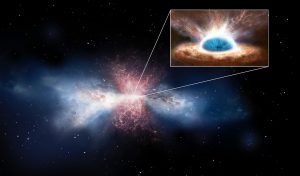
Black holes are among the most fascinating objects in our Universe – being extremely dense, with such strong gravitational attraction that not even light can escape their grasp, and being some of the most productive energy sources in our Universe. Since more than two decades, supermassive black holes (SMBH, > 10^6M⊙) have been generally accepted to ubiquitously exist in our Universe and are thought to reside in the centres of most if not all galaxies in our Universe.
The accretion of matter onto a SMBH, can result in strong nuclear emission in galaxies, observed as excess-stellar emission in the radio, infrared, optical, ultraviolet and X-ray wavelength ranges such that the galaxy is appearing as an active galactic nuclei (AGN). Details of the nuclear region around a SMBH in a galaxy are complex: it is composed of (i) a gas accretion disk, releasing energy primarily via radiation into the ambient medium, (ii) radio jets, mostly producing non-thermal emission and feedback, (iii) a dusty torus surrounding the central engine and (iv) ionised regions emitting prominent emission lines. Over the last two decades, conclusive evidence has been accumulated suggesting that the growth of SMBHs and that of their host galaxies is strongly connected and intertwined, potentially due to AGN feedback processes. Nevertheless, many facets of our current “co-evolution” picture are still under debate, e.g. to what extent AGN feedback self-regulates the growth of SMBHs and affects the evolution of their host galaxies at different cosmic epochs.
Numerical simulations have proven to be a powerful tool when trying to address fundamental questions of SMBH growth and feedback. But individual BH physical processes, and their interplay with the host galaxy, combined with the extreme dynamical range needed to simulate both the large-scale, cosmological structures of galaxies and the small-scale physics near the SMBHs, makes it very challenging to accurately capture all the effects AGN may have on their host galaxies. At GALSPEC, we aim at connecting large scales of cosmological simulations to small scales, closely followed by high-resolution idealised galaxy simulations. The latter simulations allow us (i) to accurately model the most vital physics involved at the accretion of gas onto a SMBH and the related AGN feedback, and (ii) thus, to develop associated, sub-grid schemes as a basis for cosmological simulations.
